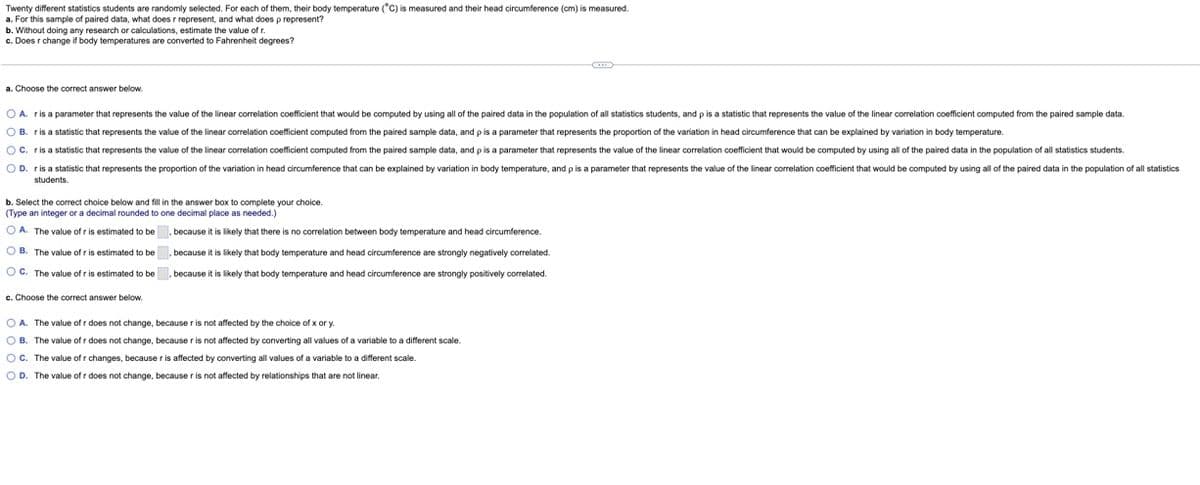correlation coefficient computed from the paired sample data, and p is a parameter that represents the proportion of the variation in head circumference that can be explained by variation in correlation coefficient computed from the paired sample data, and p is a parameter that represents the value of the linear correlation coefficient that would be computed by using all of the p variation in head circumference that can be explained by variation in body temperature, and p is a parameter that represents the value of the linear correlation coefficient that would be comp x to complete your choice. e as needed.) likely that there is no correlation between body temperature and head circumference. likely that body temperature and head circumference are strongly negatively correlated. likely that body temperature and head circumference are strongly positively correlated fected by the choice of x ory. fected by converting all values of a variable to a different scale. onverting all values of a variable to a different scale. fected by relationships that are not linear.
correlation coefficient computed from the paired sample data, and p is a parameter that represents the proportion of the variation in head circumference that can be explained by variation in correlation coefficient computed from the paired sample data, and p is a parameter that represents the value of the linear correlation coefficient that would be computed by using all of the p variation in head circumference that can be explained by variation in body temperature, and p is a parameter that represents the value of the linear correlation coefficient that would be comp x to complete your choice. e as needed.) likely that there is no correlation between body temperature and head circumference. likely that body temperature and head circumference are strongly negatively correlated. likely that body temperature and head circumference are strongly positively correlated fected by the choice of x ory. fected by converting all values of a variable to a different scale. onverting all values of a variable to a different scale. fected by relationships that are not linear.
Glencoe Algebra 1, Student Edition, 9780079039897, 0079039898, 2018
18th Edition
ISBN:9780079039897
Author:Carter
Publisher:Carter
Chapter10: Statistics
Section10.1: Measures Of Center
Problem 13PPS
Related questions
Question
5

Transcribed Image Text:Twenty different statistics students are randomly selected. For each of them, their body temperature (°C) is measured and their head circumference (cm) is measured.
a. For this sample of paired data, what does r represent, and what does p represent?
b. Without doing any research or calculations, estimate the value of r.
c. Does r change if body temperatures are converted to Fahrenheit degrees?
a. Choose the correct answer below.
OA. ris a parameter that represents the value of the linear correlation coefficient that would be computed by using all of the paired data in the population of all statistics students, and p is a statistic that represents the value of the linear correlation coefficient computed from the paired sample data.
OB. ris a statistic that represents the value of the linear correlation coefficient computed from the paired sample data, and p is a parameter that represents the proportion of the variation in head circumference that can be explained by variation in body temperature.
OC. r is a statistic that represents the value of the linear correlation coefficient computed from the paired sample data, and p is a parameter that represents the value of the linear correlation coefficient that would be computed by using all of the paired data in the population of all statistics students.
OD. ris a statistic that represents the proportion of the variation in head circumference that can be explained by variation in body temperature, and p is a parameter that represents the value of the linear correlation coefficient that would be computed by using all of the paired data in the population of all statistics
students.
b. Select the correct choice below and fill in the answer box to complete your choice.
(Type an integer or a decimal rounded to one decimal place as needed.)
OA. The value of r is estimated to be, because it is likely that there is no correlation between body temperature and head circumference.
OB. The value of r is estimated to be, because it is likely that body temperature and head circumference are strongly negatively correlated.
OC. The value of r is estimated to be because it is likely that body temperature and head circumference are strongly positively correlated.
c. Choose the correct answer below.
OA. The value of r does not change, because r is not affected by the choice of x or y.
OB. The value of r does not change, because r is not affected by converting all values of a variable to a different scale.
OC. The value of r changes, because r is affected by converting all values of a variable to a different scale.
O D. The value of r does not change, because r is not affected by relationships that are not linear.
Expert Solution
This question has been solved!
Explore an expertly crafted, step-by-step solution for a thorough understanding of key concepts.
Step by step
Solved in 3 steps

Recommended textbooks for you

Glencoe Algebra 1, Student Edition, 9780079039897…
Algebra
ISBN:
9780079039897
Author:
Carter
Publisher:
McGraw Hill

Big Ideas Math A Bridge To Success Algebra 1: Stu…
Algebra
ISBN:
9781680331141
Author:
HOUGHTON MIFFLIN HARCOURT
Publisher:
Houghton Mifflin Harcourt

Holt Mcdougal Larson Pre-algebra: Student Edition…
Algebra
ISBN:
9780547587776
Author:
HOLT MCDOUGAL
Publisher:
HOLT MCDOUGAL

Glencoe Algebra 1, Student Edition, 9780079039897…
Algebra
ISBN:
9780079039897
Author:
Carter
Publisher:
McGraw Hill

Big Ideas Math A Bridge To Success Algebra 1: Stu…
Algebra
ISBN:
9781680331141
Author:
HOUGHTON MIFFLIN HARCOURT
Publisher:
Houghton Mifflin Harcourt

Holt Mcdougal Larson Pre-algebra: Student Edition…
Algebra
ISBN:
9780547587776
Author:
HOLT MCDOUGAL
Publisher:
HOLT MCDOUGAL